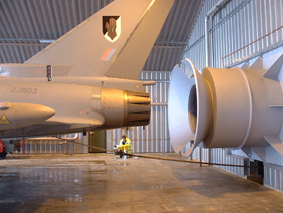
A hush house is an enclosed, noise-suppressed facility used for testing aircraft systems, including propulsion, mechanics, electronics, pneumatics, and others. [1] Installed or uninstalled jet engines can be run under actual load conditions.
Testing
A hush house is large enough to accommodate an entire crewed or uncrewed aircraft. Some facilities are also equipped to test additional capabilities such as weight and balance, night vision and low lighting, water intrusion, heat soaking, and wind evaluation. [1]
Jet engines can be run while installed in the aircraft, which must be restrained by holdback devices to resist the engine thrust. Engines removed from an airplane can be tested while held in place by thrust frames.
The air intake and exhaust systems of indoor engine test cells and hush houses are designed to block the transmission of noise, while optimizing the engine air flows. The engine exhaust, after having been thoroughly mixed with cooling air, is generally discharged through a vertical stack. The gas path incorporates acoustic damping panels (often containing fibrous insulation protected from gas stream erosion by metal mesh) to reduce the sound energy of the gas stream and attenuate the noise transmitted to the surrounding outdoor area.
Because the engine exhaust flow is "augmented" with a relatively large flow of cooling air induced by a Venturi effect into the exhaust silencing system, the exhaust muffler of an indoor test facility is generally referred to as an augmenter tube, although the term "detuner" is commonly used in the UK.[ citation needed]
Some outdoor run-up facilities used to test aircraft engines (installed or uninstalled) may also be outfitted with noise control structures, called Ground Run-Up Enclosures. [2] [3] [4]
Examples
- Marine Corps Air Station Miramar in San Diego California
- Marine Corps Air Station Iwakuni in Japan [5]
- Naval Air Station Jacksonville in Jacksonville, Florida [6]
- Naval Air Station Joint Reserve Base Fort Worth in Fort Worth, Texas [7]
- Naval Air Station Oceana in Virginia Beach, Virginia [8] [9]
- Naval Air Station Patuxent River in Maryland [10]
References
- ^ a b "Aircraft Test & Evaluation Facility (Hush House)". Naval Air Warcraft Center Aircraft Division. United States Navy. Retrieved 7 January 2018.
- ^ "Ground Run-up Enclosures (GREs)". IAC Acoustics. Sound Seal. Retrieved 7 January 2018.
- ^ Ground Run-Up Procedures Manual, Chicago O'Hare International Airport (PDF), Chicago Department of Aviation, November 10, 2015, p. 1, retrieved 7 January 2018
- ^ Swartz, Kenneth I. (April 20, 2017). "Good neighbour; quiet neighbour". Skies Magazine. Retrieved 7 January 2018.
- ^ Cruz Jr., Cpl. Carlos (December 14, 2015). "Hush houses reduce noise in Iwakuni, Japan". Marine Corps Air Station Iwakuni, Japan. United States Marines. Retrieved 7 January 2018.
- ^ "'Hush House' Quiets Navy Jet Tests". Florida Times Union. September 14, 1996. Retrieved 7 January 2018.
- ^ Haley, Betsy (July 26, 2004). "JRB Fort Worth Reserve team embraces NAVRIIP". Naval Air Systems Command. United States Navy. Retrieved 7 January 2018.
- ^ "Field Operations Engine Maintenance". Naval Air Station Oceana. United States Navy. Retrieved 7 January 2018.
- ^ "Aircraft Acoustical Enclosure Oceana Hush House". Projects. W. M. Schlosser Company. Retrieved 7 January 2018.
- ^ "A 'Hush Rush' keeps the T-45 flying". NAVAIR News Release. United States Navy. January 14, 2013. Retrieved 7 January 2018.